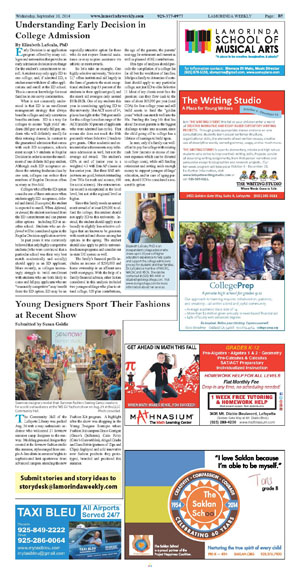|
|
Published September 10th, 2014
|
Understanding Early Decision in College Admission
|
|
| By Elizabeth LaScala |
 |
| Elizabeth LaScala, Ph.D. is an independent college advisor who draws upon 25 years of higher education experience to help guide and support the college admissions process for students and their families. Dr. LaScala is a member of NACAC, WACAC and HECA. She can be contacted at (925) 891-4491 or elizabeth@doingcollege.com. Visit www.doingcollege.com for more information about her services. |
Early Decision is an application program offered by many colleges and universities that provides an early admission decision in exchange for the student's commitment to enroll. A student may only apply ED to one college, and, if admitted ED, a student must withdraw all other applications and enroll at the ED school. This is common knowledge for most families in our savvy communities.
 What is not commonly understood is that ED is an enrollment management strategy that always benefits colleges and only sometimes benefits students. ED is a way for colleges to secure 'high yield' students (full pay or nearly full pay students who will definitely enroll) for their entering classes. In contrast to the guaranteed admission that comes with each ED acceptance, schools must accept 3-5 students in Regular Decision in order to secure the enrollment of one definite full-pay student. Although each ED acceptance reduces the entering freshman class by one seat, colleges can reduce their numbers of Regular Decision offers as many as five-fold.
What is not commonly understood is that ED is an enrollment management strategy that always benefits colleges and only sometimes benefits students. ED is a way for colleges to secure 'high yield' students (full pay or nearly full pay students who will definitely enroll) for their entering classes. In contrast to the guaranteed admission that comes with each ED acceptance, schools must accept 3-5 students in Regular Decision in order to secure the enrollment of one definite full-pay student. Although each ED acceptance reduces the entering freshman class by one seat, colleges can reduce their numbers of Regular Decision offers as many as five-fold.
 Colleges who offer the ED option consider one of three outcomes when students apply ED: acceptance, deferral and denial. If accepted, the student is expected to enroll. When deferred, or denied, the student is released from the ED commitment and can pursue other options - including ED at another school. Students who are deferred will be considered again in the Regular Decision application review.
Colleges who offer the ED option consider one of three outcomes when students apply ED: acceptance, deferral and denial. If accepted, the student is expected to enroll. When deferred, or denied, the student is released from the ED commitment and can pursue other options - including ED at another school. Students who are deferred will be considered again in the Regular Decision application review.
 In past years it was commonly believed that only highly competitive students (who were convinced that a particular school was their very best match academically and socially) should apply as an ED applicant. More recently, as colleges increasingly struggle to build enrollment with students who are both likely to come and full pay, applicants who are "reasonably competitive" may benefit from the ED option. ED may be an especially attractive option for those who do not require financial assistance or may acquire assistance via athletic or merit awards.
In past years it was commonly believed that only highly competitive students (who were convinced that a particular school was their very best match academically and socially) should apply as an ED applicant. More recently, as colleges increasingly struggle to build enrollment with students who are both likely to come and full pay, applicants who are "reasonably competitive" may benefit from the ED option. ED may be an especially attractive option for those who do not require financial assistance or may acquire assistance via athletic or merit awards.
 So let's take an example. One highly selective university, "Selective U," offers institutional aid largely in the form of grants to the most exceptional students (top 15 percent of the students in their applicant pool) and the merit aid averages only around $10k-$12k. One of my students this year is considering applying ED to this university. Her ACT score of 34, places her right at the 75th percentile for this college's median range of the ACT (middle 50 percent of applicants who were admitted last cycle). That means she does not reach the 85th percentile where Selective U tends to give grants. Other academic and extracurricular achievements may influence admission as well, but not the average aid award. The student's GPA at end of junior year is a weighted 4.3 with four AP classes in her senior year. Her three SAT subject tests are good, but not outstanding (low 700s for math and science, 690 for social science). Her extracurricular record is exceptional at the local level, but not at the regional level or higher.
So let's take an example. One highly selective university, "Selective U," offers institutional aid largely in the form of grants to the most exceptional students (top 15 percent of the students in their applicant pool) and the merit aid averages only around $10k-$12k. One of my students this year is considering applying ED to this university. Her ACT score of 34, places her right at the 75th percentile for this college's median range of the ACT (middle 50 percent of applicants who were admitted last cycle). That means she does not reach the 85th percentile where Selective U tends to give grants. Other academic and extracurricular achievements may influence admission as well, but not the average aid award. The student's GPA at end of junior year is a weighted 4.3 with four AP classes in her senior year. Her three SAT subject tests are good, but not outstanding (low 700s for math and science, 690 for social science). Her extracurricular record is exceptional at the local level, but not at the regional level or higher.
 Since this family needs an annual merit award of at least $25,000 to afford the college, this student should not apply ED to this university. Instead, the student should apply more broadly to slightly less selective colleges that are known to be generous with merit aid and choose among her options in the spring. The student should also apply to public universities honors programs and consider our in-state UC system as well.
Since this family needs an annual merit award of at least $25,000 to afford the college, this student should not apply ED to this university. Instead, the student should apply more broadly to slightly less selective colleges that are known to be generous with merit aid and choose among her options in the spring. The student should also apply to public universities honors programs and consider our in-state UC system as well.
 The family's financial profile includes an income of $230,000 and home ownership in an affluent area (with mortgage). With the help of a family financial advisor, other factors considered in this analysis included two younger siblings who plan to attend college, 529 plan contributions, the age of the parents, the parents' nest egg for retirement and current as well as planned 401K contributions.
The family's financial profile includes an income of $230,000 and home ownership in an affluent area (with mortgage). With the help of a family financial advisor, other factors considered in this analysis included two younger siblings who plan to attend college, 529 plan contributions, the age of the parents, the parents' nest egg for retirement and current as well as planned 401K contributions.
 This type of analysis should precede the compilation of a college list for all but the wealthiest of families. It helps a family to determine if a student should apply to any particular college, not just ED to elite Selective U. Most of my clients must face the question: can they flow cash to the tune of about $65,000 per year (total COA) for four college years and still build assets to fund the "golden years" which can stretch well into the 90s. Funding the long life that lies ahead for most parents is the biggest challenge to take into account, since the child going off to college has a lifetime of earnings to build upon.
This type of analysis should precede the compilation of a college list for all but the wealthiest of families. It helps a family to determine if a student should apply to any particular college, not just ED to elite Selective U. Most of my clients must face the question: can they flow cash to the tune of about $65,000 per year (total COA) for four college years and still build assets to fund the "golden years" which can stretch well into the 90s. Funding the long life that lies ahead for most parents is the biggest challenge to take into account, since the child going off to college has a lifetime of earnings to build upon.
 In sum, only if a family can well-afford to pay for college with existing cash flow (income in excess of current expenses which can be diverted to college costs), while still funding retirement and setting aside enough money to support younger siblings' education, and/or care of aging parents, should ED be considered a reasonable option.
In sum, only if a family can well-afford to pay for college with existing cash flow (income in excess of current expenses which can be diverted to college costs), while still funding retirement and setting aside enough money to support younger siblings' education, and/or care of aging parents, should ED be considered a reasonable option.

|
|
|
|
|
|
|
|
|
| |
|
|
|
|



